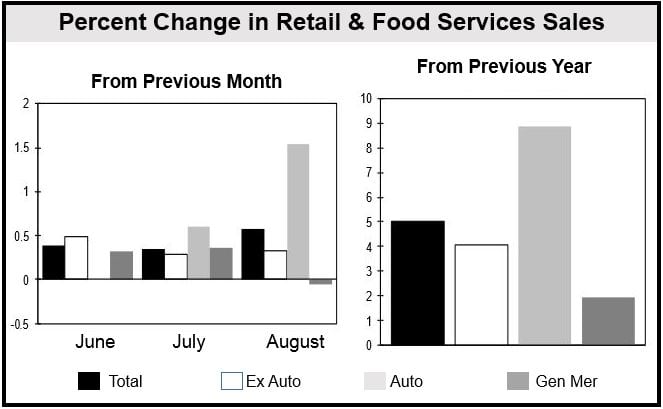Lower gasoline prices and a firmer labor market helped push up US August retail sales to $444.4 billion, 0.6% higher than in July, and a 5% rise compared to August 2013, according to the US Census Bureau, part of the Commerce Department.
As consumer sentiment across most of the country improves, households are spending more.
Sales for the Jun-Aug 3-month period were 4.5% higher than during the same period in 2013. July’s increase in relation to June remained virtually unchanged at 0.3%.
Sales improved for a wide range of retailers and restaurants in August. Spending at department stores, however, were marginally down.
Building material sales increased by 1.4%, the largest gain since April. Sales at appliance and furniture stores rose 0.7%.
Sales at gas filling stations declined by 0.8% in August compared to July, and fell by 1.2% since the beginning of the year.
With household spending accounting for over two-thirds of GDP (gross domestic product), today’s retail figures bode well for economic growth in Q3 2014.
According to a survey of economists carried out by the Wall Street Journal this week, the US economy is forecast to grow by 3% (annualized) in Q3 and Q4 2014. In the second quarter, GDP expanded by 4.2% after shrinking by 2.1% in Q1.
(Data Source: US Census Bureau)
Job gains slowed – jobless claims rose
August job gains were much lower than expected. The Bureau of Labor Statistics reported that nonfarm payroll employment increased by 142,000 in August, which reduced the unemployment rate by 0.1 of a percentage point to 6.1%.
With most months this year posting at least 200,000 gains, August was relatively disappointing.
Retail sector payroll numbers declined in August for the first time since February, while manufacturing remained flat.
August’s labor force data are likely to make the Federal Reserve postpone any thoughts of raising the benchmark interest rate.
Jobless claims: the number of Americans filing for unemployment benefit reached a 2-month high on the week ending on September 6th. However, the Labor Department emphasized numbers are still near pre-crisis levels.
There were 11,000 more jobless claims than in the previous week, reaching a total of 315,000.
The period included Labor Day – national holidays are notorious for skewing figures, i.e. later on they usually updated with quite different results.

